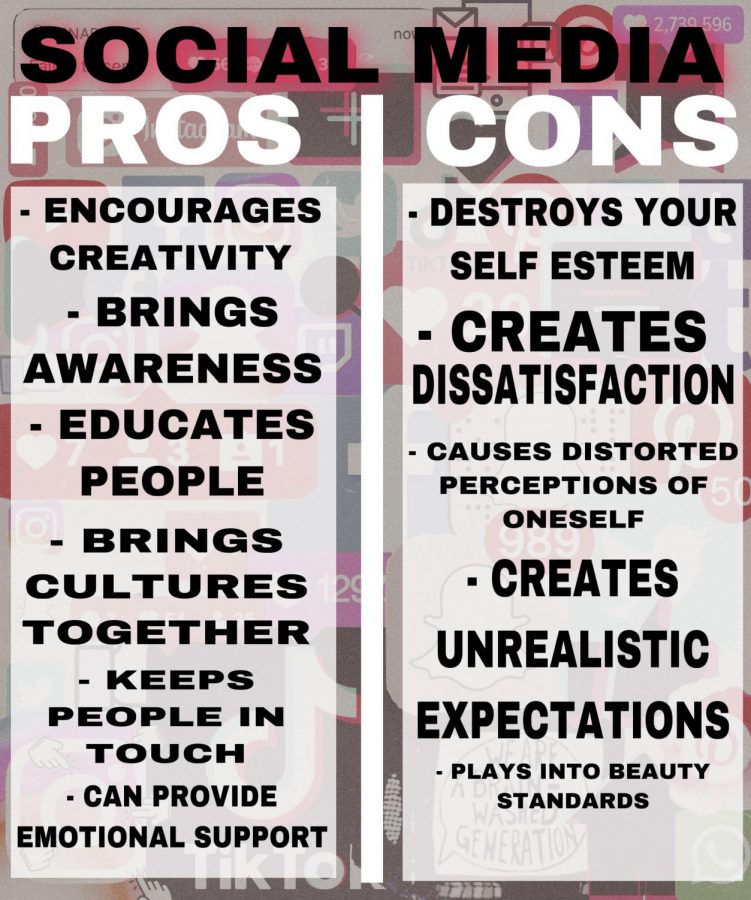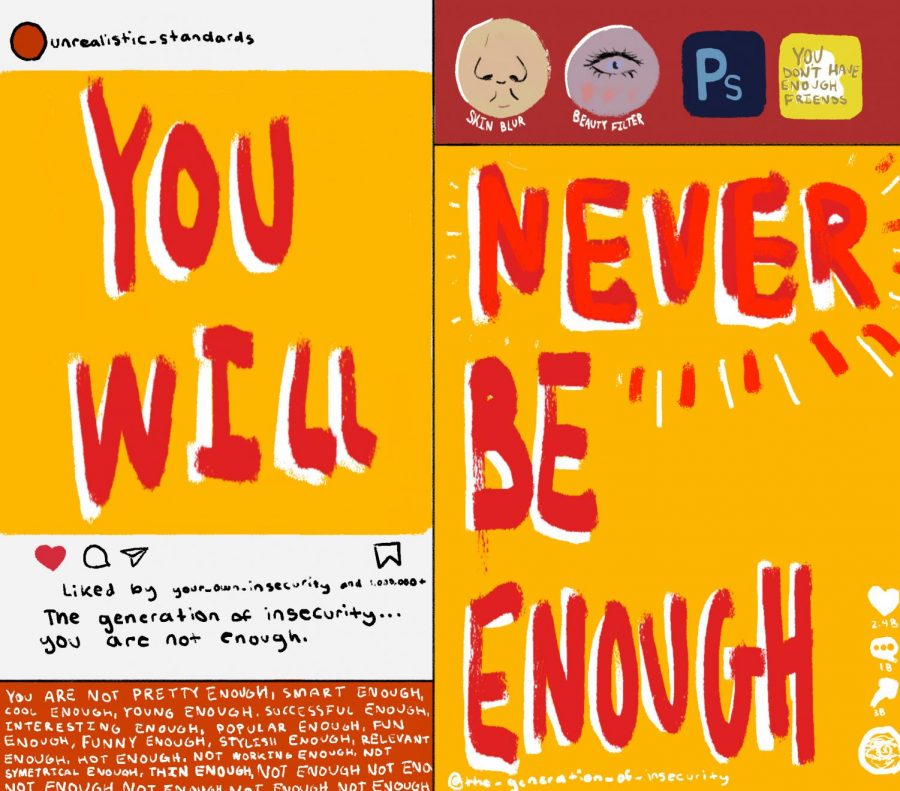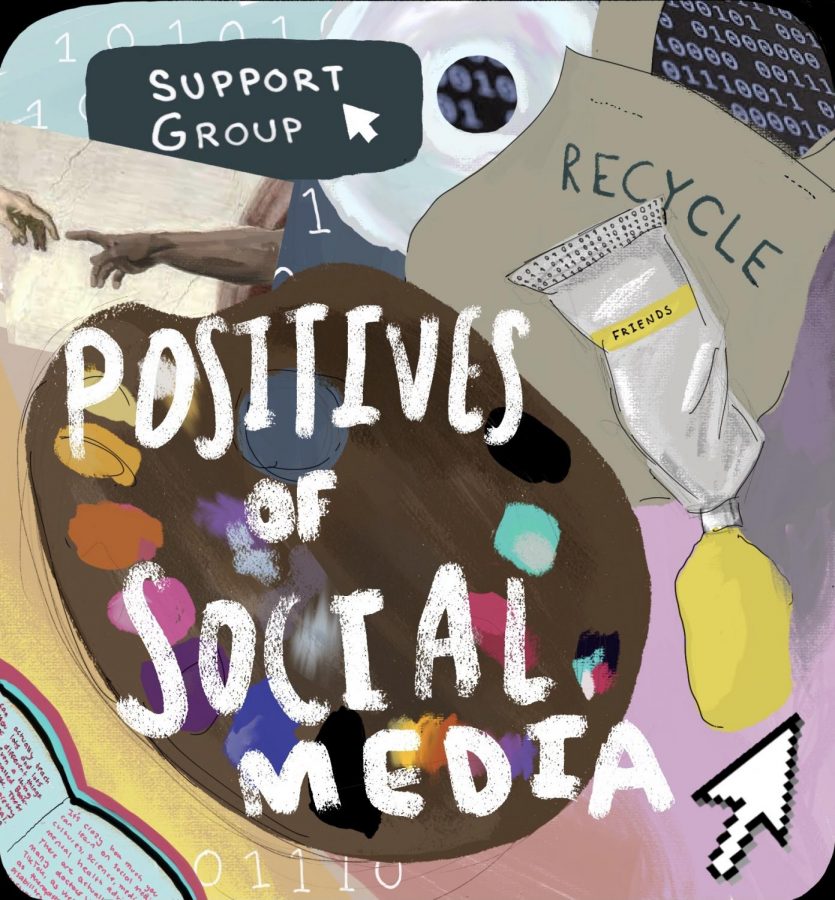What are the dangerous, or what are the pros of being on social media. be careful of what you wish for on social media, because it can go both way
Pros & Cons to Social Media
September 12, 2021
You Will Never Be Enough: Anti-Social Media
At this point, everyone knows faces and bodies are often photoshopped on Instagram- the side by side of photos from real life and ones from Instagram have been floating around for years now. Everyone knows that videos are edited to leave out the ‘bad’ parts. Everyone knows viewers are easily manipulated through photos and videos, and most people know that the amount of likes they receive does not reflect their likability as a person or their talen. But the longer you’re on social media, the harder it is to remember these things, the harder it is to believe this, the harder it is to shake those negative voices that were implanted into your head.
Social media of all forms is a degrading and addictive part of over 3.96 billion people’s daily lives. In 2020, the average person owned 8.6 social media accounts. The average time spent on these accounts a day was 2 hours and 24 minutes
Instagram is a particularly corrosive app with many ways it actively harms people’s confidence and satisfaction with their reality, a cesspool of shame.
Instagram is filled with plastic surgery, photoshopped faces and bodies, people showing off their ‘amazing’ lives, advertisements pushing diet pills and new exercises for weight loss, and it clearly displays one single image of ‘beauty’. Skin is brushed to be freed of texture. Waists are cinched inwards with a computer mouse, just as thighs are expanded. Jaws are tweaked to be even on both sides. Cheekbones are accentuated by being pulled inward and shaded in a certain way. Noses are made to be smaller. According to a 2017 study conducted by Cognitive Research, people can only tell an image is manipulated 65% of the time… a percentage that has likely risen since due to the better applications meant to tweak them. Clearly, this is having an effect: as found by a 2020 study done by Eldamen Data & Intelligence, 80% of girls have utilized a filter or altered the way they look through apps by the time they are 13 years old.
On Instagram, you are taught that only a few features will deem you as beautiful, and an absence of any of them will make you ugly. As a result, from celebrities to normal people, everyone has started to look unnervingly similar. With society and consumers caught in a ruthless cycle, those who fit that one look garner far more attention than those who don’t. Thus, it is seemingly confirmed to everyone that one must look a certain way to have value, that your looks are more important than the depth or value of anything you have to say and the impact of anything you do- a certain way that most people don’t even naturally look like, and a way people go as far to risk their lives through plastic surgery to achieve.
On TikTok, the experience is similar to that of instagram. Every once in a while, a girl will come up on the ‘for you’ page wielding a new feature to be insecure about, a new trend made solely for the purpose of validation. TikTok is relentless with body validation and shame trends. First came the comparison of side profiles and a focus on petite noses, then came the reverse camera to highlight the lack of perfect symmetry of your face . Then came , and then the glow filter
Coming from an already insecure girl, before TikTok, I had never felt insecure about the symmetry of my face, I never noticed that my jaw is slightly uneven. Before TikTok, I never absolutely loathed my side profile, albeit I had some insecurities about it.
Glow filter. “If it looks fake on you, you’re just pretty. If it looks natural, you’re beautiful.” I know this statement is absolutely meaningless, I know it’s based off of nonexistent facts, I know this statement was completely pulled out of thin air. It was a stupid statement. But when my curiosity and insecurities got the best of me and I tried that filter, and no matter what lighting I was in it looked incredibly fake, that statement got to me. I felt insecure and shameful.
I downloaded TikTok for the art content. I mainly use it for the art content. But somehow, these little insecurities will slip into my for you page, and thus into my mind, and then plant ideas in my head that are hard to uproot. Snapchat, Instagram, and TikTok are all guilty of making users self conscious through their unrealistic and overproduced filters.
Social media also plays into social status and allows for quantifiable comparison, centering around the like feature and the comments left and followers and, on Snapchat, how many friends a person has and if their “best friend” doesn’t have them as their best friend back.
Well, that person has way more likes than me. Do people hate me? What does that person have that I don’t? Why have they received more comments about how pretty they are than I have? It convinces you to believe that worth is determined by popularity and adoration, when worth has absolutely nothing to with either. Every platform has a like feature to give users a quantifiable method of comparison- which makes the sources seem more valid- to others, and comments that nitpick your life and provide yet another easy method of comparison. And even though Instagram made it possible for users to remove likes, very few actually have. With users feeling safe behind their screens, the comments can be absolutely ruthless and resort to attacking a person’s looks because they didn’t like their opinion. TikTok is especially guilty of this.
Social media also provides viewers with a very tailored, very curated life, and thus, due to the ability to shape your life however you want it to look, gives an unrealistic and ‘perfect’ reality- a reality they themselves don’t even live up to in real life. Nonetheless, expectations are set, especially for younger audiences who are more impressionable. It’s easy to look at someone’s social media life and compare it to your own and feel as though you’re missing out or falling behind or envy what they have that you don’t. Social Media provides a quick way to compare your real relationships with couples at their best. It provides an easy way to compare your own body to someone else’s. This comparison is beyond harmful and oddly addicting, a never ending search for validation you will not receive. I know I have personally used social media to feed my own self hatred and consciousness.
But Social Media Isn’t All Bad: What Social Media Could Be
Social media encourages creativity and develops artistic ability, informs people, offers support, and brings different cultures together.
A place where artists can express themselves, where people have a genuine interest in learning, different cultures come together, those with struggles find solace in having people with similar afflictions, passions are explored and shared; Social media certainly has its negative effects on society, effects that are serious and grave- social media could even have a negative impact on society overall. However, social media, like most things, is not all black and white, and it has the chance to be something great, something empowering, impactful, and positive for society. Here are the positives of social media.
Social media can be a space of creativity and endless possibilities, a place that encourages ingenuity and offers an outlet for artistic expression. Instagram and TikTok have a plethora of artists, some beginner and some expert, and Tumblr and Quora have many different spaces where writers can share their poetry, short stories, and likewise. Social media effectively gives creative people a place where they have a voice, a place where they can actually share with the world what they work so tirelessly on. Many artists actually find recognition on Instagram and TikTok too, and even go on to sell their work. Social media also gives musicians a platform as well, one they can share the songs they wrote themselves on- some small, independent or aspiring musicians have gathered an audience purely out of their use of social media. The well known and insanely popular Olivia Rodrigo’s success was largely due to TikTok using her music as sounds. Tate McRae, a young singer-songwriter, started posting her songs on TikTok and soon after released an album and a single in 2021 when her music took off from there. In 2019, according to an article by Music Business Worldwide, seventy different musicians that started on TikTok signed with major labels.
Social media should rarely be used as a reliable or unbiased news source. However, there are plenty of instances where social media can be educational and informative; there are a plethora of art videos containing technical tips, and any art video in of itself is a tutorial. There are also many cooking videos, and there are an abundance more of videos on novels- TikTok even has a subculture referred to as ‘BookTok’. The TikTok user ‘Hood Nature’ makes videos on the animal kingdom, and Tabitha Brown shares her vegan recipes.
Social media is also filled with articulate opinions and historical information (although checking your source’s validity is particularly crucial for this one), another source of information people find through social media they maybe wouldn’t have found otherwise. Many certified doctors- Dr. Kunal Sood, MD, for example– have online presences where they debunk myths and give out advice, as well as licensed therapists- such as Dr. Julie Smith, PhD- who shed light on mental health, destigmatize it, and provide coping methods for thousands of people who can’t afford therapy or are too afraid to speak up for themselves and make that step. Incredibly, all of the education is free.
Along the lines of social media’s ability to provide valuable information, social media can effectively bring together people of different ethnic and cultural backgrounds, educating people who would otherwise be ignorant.
Social media also brings awareness to issues, from environmental destruction and how you can help prevent it to what it’s like for people who struggle with certain illnesses or disabilities. People are empowered to raise their voices for the greater good, touched by the hardship of others and encouraged to speak in a place in which they actually have a chance of being heard. On social media, people can redirect others to donations, protest locations, petitions, and ethically sourced stores.
Not only are illnesses and disabilities destigmatized and brought attention to, but those who personally struggle with these now have a person or even a whole community of people who also share that struggle. There are many support groups online, particularly on Facebook, and being in one- or even just finding one social media page with a person who openly talks about their struggle- can be incredibly healing, informative, and comforting. It’s one thing to have loved ones who care for you, but it’s another thing to have someone that gets it, that understands your pain, who’s lived in it.
People with struggles aren’t the only ones benefited by social media groups. Like-minded people from all paths of life can come together and bond over just about anything, able to freely discuss their passions with those who are genuinely interested in what they have to express. Communities are outlets for a lot of people who love something but don’t have someone who shares a love for it, whether this is the incredibly broad online world of art, or a specific fandom centered around a single novel. Social media fosters communication and communities, whether centered around a shared favorite television series or a mutual love for cuisine.
Social media also allows for friends who don’t see each other often to stay in touch.
There are many, many downfalls to social media. But despite the great debate of whether social media has a negative net, just as the negatives should not be, the positives should not be neglected either. Social media has the chance to be a source and inspiration for great creativity, passion, education, and culture. Let’s not pitch it altogether, but work to free it of its faults instead.



